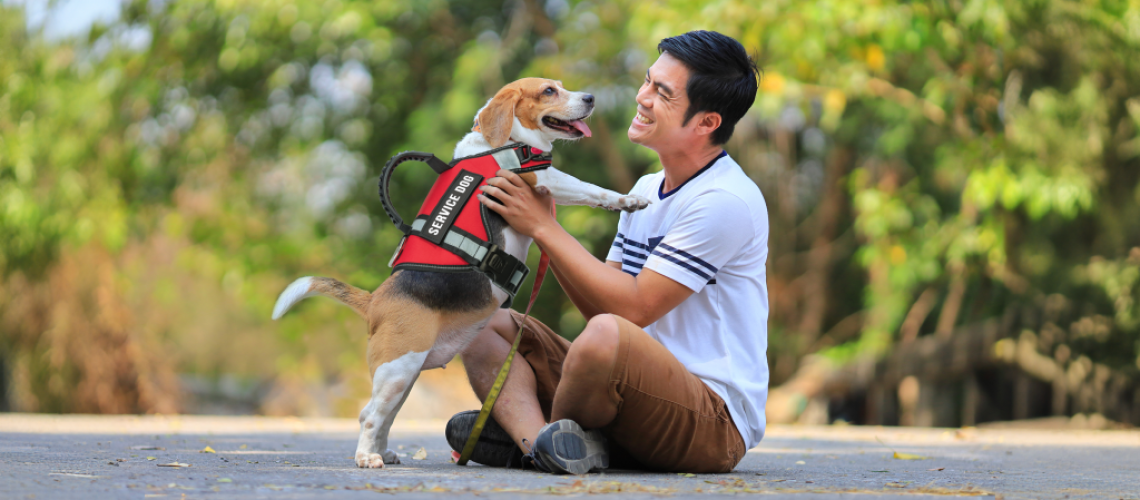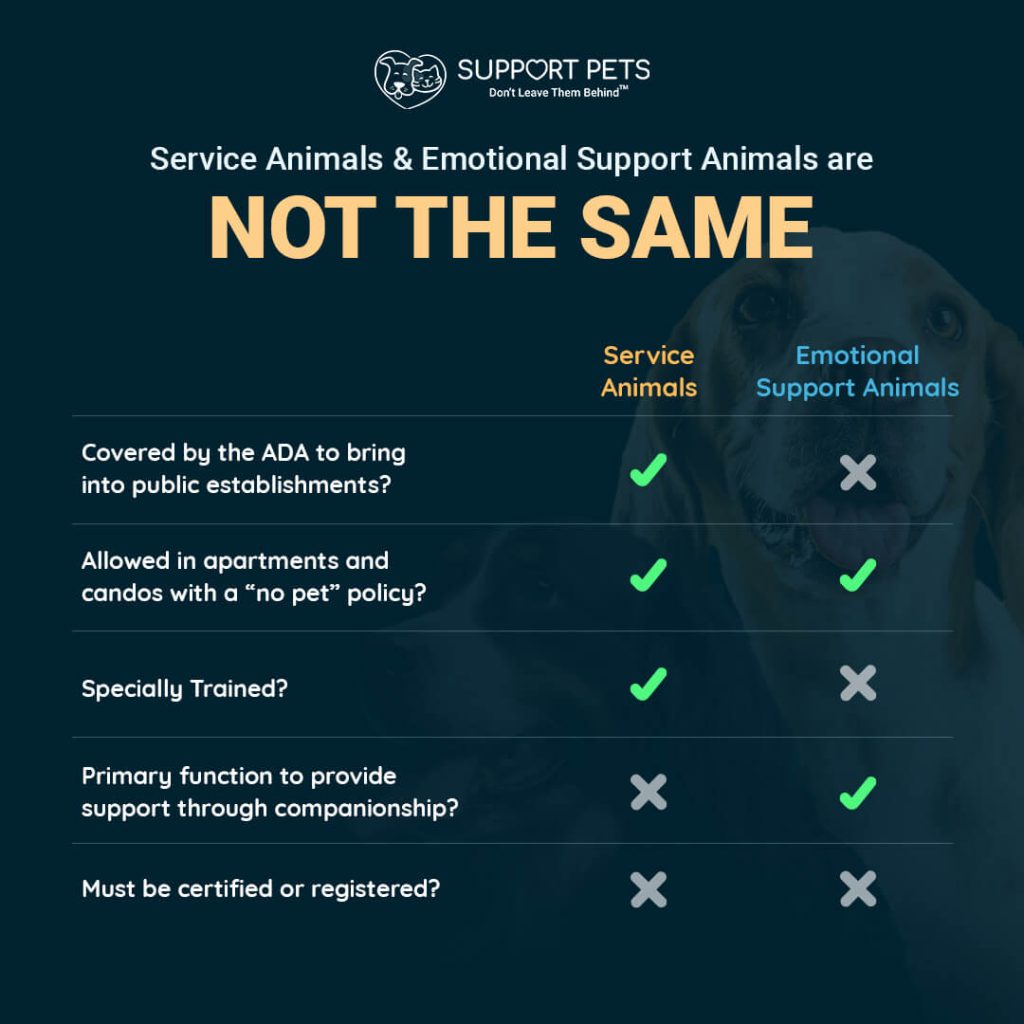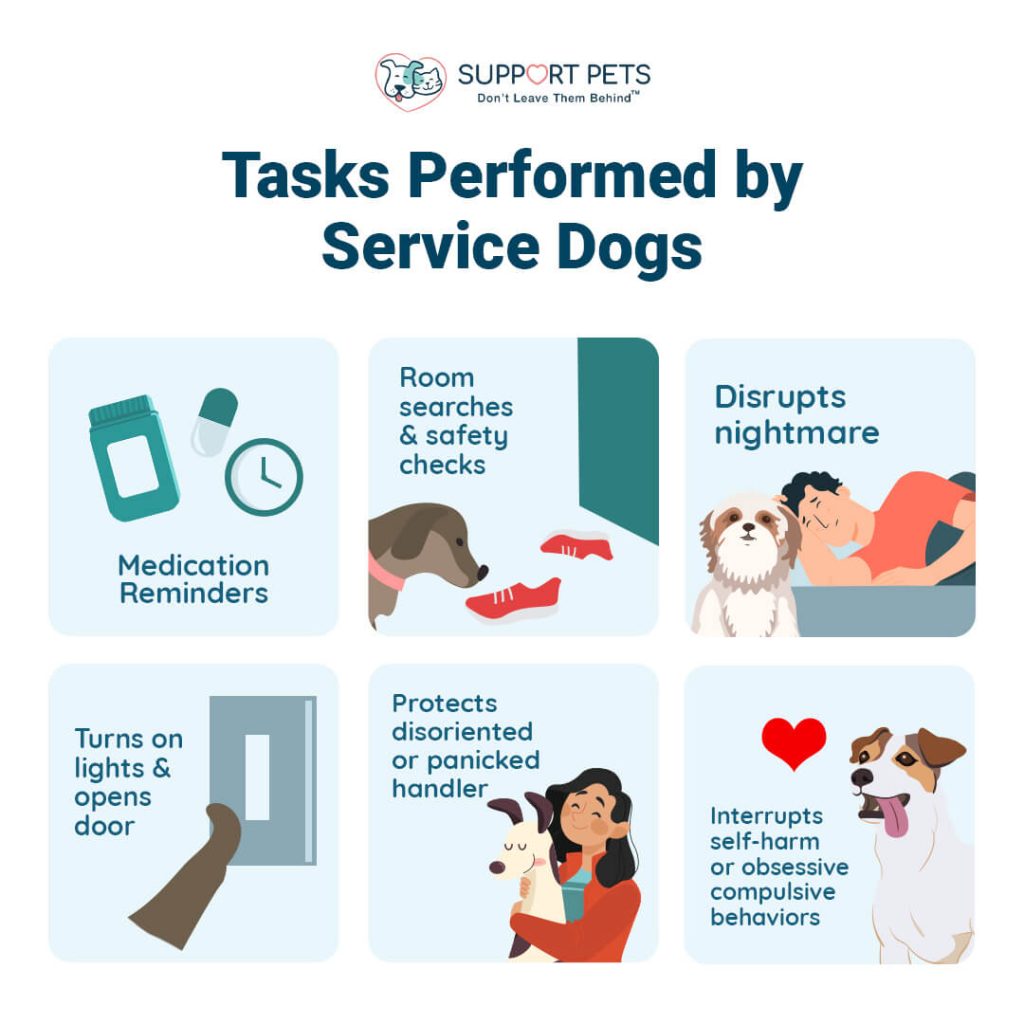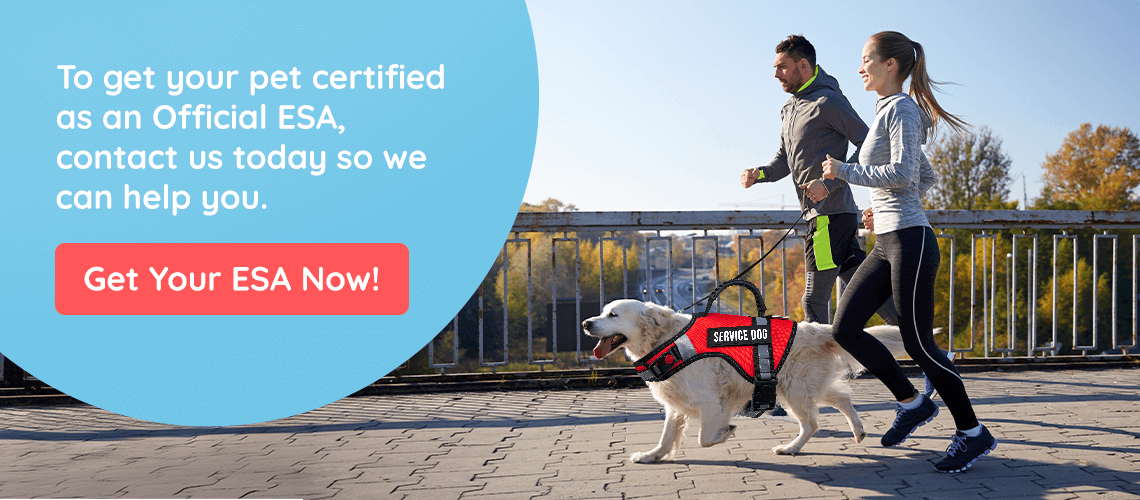A service dog vest can do more than identify your dog—it can make your day-to-day feel a little less stressful. You might be wondering, “Do service dogs have to wear a vest?” It’s a fair question, and one we hear often. The answer? Service dog vests aren’t legally required under the Americans with Disabilities Act (ADA). But many people still choose to use one for comfort, confidence, and clarity.
Whether you’re looking for a psychiatric service dog vest to support your mental health or just curious about how to get a service dog vest, this guide is here to walk you through it all. We’ll cover what’s required (and what’s not), the real benefits of using a service vest for dogs, and where to find options that are both practical and reliable.
At Support Pets, we believe your connection with your service animal is personal, and getting the right tools shouldn’t feel overwhelming. This is about making life easier, together.
Do Service Dogs Have to Wear a Vest?
This is a common question, and according to the Americans with Disabilities Act (ADA), the answer is no. Service dogs aren’t legally required to wear a vest, harness, or any special gear when accompanying their handler in public places like restaurants, stores, or on public transportation.
But even though it’s not required, many handlers choose to use a service dog vest—and for good reason. A brightly colored service vest for dogs helps the public understand that your animal is working. It can reduce questions, limit distractions, and offer you a little more peace of mind when you’re out and about.
So while the law doesn’t say your dog has to wear one, the right service dog vest can help make your daily experience smoother, more respectful, and less stressful.
Can Anyone Buy a Service Dog Vest?
Yes—anyone can buy a service dog vest online or in stores. There’s no law that limits who can purchase one, and since service dog vests aren’t required by the ADA, sellers don’t ask for proof that your dog is a trained service animal.
But here’s the thing: just putting a service vest on a dog doesn’t make them a service dog.
Service dogs go through special training to help with specific tasks related to a disability. This includes psychiatric service dogs, which are trained to support mental health conditions like anxiety, PTSD, or panic disorders. These dogs may wear a psychiatric service dog vest, but their training—not the vest—gives them legal access rights.
You might also see emotional support dog vests, which can be helpful for Emotional Support Animals (ESAs)—but keep in mind, emotional support animals aren’t trained for specific tasks, so they don’t have the same legal rights as service dogs.
Wearing a vest your dog hasn’t earned can cause confusion. In many states, misrepresenting a dog as a service animal can be a civil or criminal offense. More importantly, it makes things harder for people who truly depend on trained service animals every day.
If your dog is a legitimate service dog, a vest can be a useful signal to the public. If they’re not, there are still other ways to get the support you need—with honesty, clarity, and compassion.
Looking to train your dog as a psychiatric service animal? Our Psychiatric Service Dog Training program can help you build the skills and the bond you need to take the next step.
Benefits of Service Dog Vests
While a service dog vest isn’t legally required, it can make a meaningful difference for you, your dog, and the people around you. A vest creates clarity, sets healthy boundaries, and helps your service dog stay focused on the job they’ve been trained to do.
Here’s how a service vest for your dog can help:
Clear Identification
A service dog vest helps the public understand right away that your dog isn’t a pet, but a working partner. In busy spaces like restaurants, airports, and stores, that visual cue can reduce confusion and keep interruptions to a minimum. Whether you use a general service dog vest or a psychiatric service dog vest, the message is the same: this dog is here for a reason.
Smoother Public Access
Under the ADA, your service dog has the right to accompany you in most public spaces. But not everyone knows the law. A brightly colored vest can help staff and bystanders recognize that your dog is performing specific tasks and should be treated accordingly. That small detail can ease tension and make everyday outings feel less stressful.
Fewer Distractions
Dogs wearing a vest that says “Working” or “Do Not Pet” are more likely to be left alone, and that’s a good thing. Service dogs need to focus, especially those supporting mental health needs. Psychiatric service dog vests, in particular, help make sure your dog can do what it’s trained to do: monitor your well-being and respond in real time.
A Signal to Your Dog
A vest isn’t just helpful for the public. It also helps your dog understand when it’s time to work. When the vest comes off, your dog can relax and just be your companion. That balance supports their emotional health while reinforcing their role when the vest is back on.
Better Visibility and Safety
Service dog vests often come in bold colors with reflective details, which improves safety in crowds or low-light conditions. Whether you’re trying to cross a busy street or walk through a dim hallway, visibility matters for both of you.
Room for Important Information
Many service dog vests come with patch areas or pockets for ID cards that explain your dog’s role. Some even include ADA language about your rights as a handler. These custom touches can help set expectations and gently educate others about what it means to live and move through the world with a service animal by your side.
Understanding Service Dogs vs. Emotional Support Animals
Service dogs and emotional support animals both offer important support, but in different ways. Service dogs are specially trained to perform tasks that directly assist with a disability, while emotional support animals provide comfort through companionship.
Only service dogs are granted public access rights under the ADA. Emotional support animals, even with a letter, are not allowed in most public places where pets are typically restricted.
That’s why wearing a psychiatric service dog vest can be especially helpful—it makes it easier for others to understand your dog’s role and helps reduce questions or confusion when you’re out in the world.
Types of Service Dogs and Their Specialized Vests
Different service dogs have different jobs, and many handlers choose a specific service dog vest to reflect their dog’s training and purpose. These vests help reduce confusion in public, create clearer boundaries, and ensure the dog can focus on their work.
Here are a few common types of service dogs and how specialized vests can help support their roles:
- Seeing-Eye Dogs: Guide people with low vision through everyday tasks. A bright, high-visibility service vest for dogs helps others recognize the dog’s important role and give them space to work.
- Hearing Assistance Dogs: Alert their handler to essential sounds like alarms, doorbells, or someone calling their name. Wearing a service dog vest lets the public know the dog is there for medical support, not socializing.
- Mobility Assistance Dogs: Help people with physical disabilities by retrieving items, opening doors, or providing balance support. A vest signals that the dog is working and helps avoid unnecessary interruptions.
- Diabetic Alert Dogs: Detect changes in blood sugar and alert their handler before a medical episode. A service dog vest can also notify emergency responders that the dog may be performing an alert task.
- Psychiatric Service Dogs: Assist with mental health conditions like PTSD or anxiety by performing trained tasks such as grounding or interrupting panic attacks. A psychiatric service dog vest can discourage distractions and protect the handler’s privacy.
Each vest helps tell the story of how a dog supports their person—and makes it easier for both to move through the world with confidence.
Choosing the Right Service Dog Vest
Not all service dog vests are created equal, and picking the right one can make a big difference in your dog’s comfort and your daily experience as a handler.
What Information Should Be on a Service Dog Vest?
The best service vests for dogs make your dog’s role clear with patches or labels like “Service Dog,” “Psychiatric Service Dog,” or “Do Not Pet.” Many vests also include pockets for ID cards that explain your dog’s trained tasks or display your ADA rights. These features help set expectations and allow your dog to work without unnecessary distractions.
What Should I Look For When Choosing a Vest?
Here’s what to consider when choosing a service dog vest for your working companion:
- Comfort: Your dog may wear this for hours, so go for soft, breathable materials and an adjustable fit.
- Visibility: Bright colors and reflective strips help your dog stand out in crowds or low light.
- Durability: Look for strong stitching and weather-resistant fabrics that hold up to daily use.
- Customizability: Choose a vest that lets you attach patches to reflect your dog’s specific role and training.
Start with our free assessment to see if you qualify—and get matched with a vest that supports your service dog’s purpose and your daily peace of mind.
What Tasks Do Service Dogs Perform?
Service dogs wearing service dog vests are individually trained to perform specific tasks that help their handlers with disabilities. These dogs, identifiable by their service vests for dogs, perform important jobs that enable their handlers to live more independently and safely.
Service dogs are trained to do more than just follow commands—they help people regain independence, manage symptoms, and feel safer in everyday life.
Here are a few of the essential tasks they’re often trained to perform:
- Medication Reminders: For those managing mental health conditions, remembering daily medications can be tough. Some psychiatric service dogs are trained to alert their handler when it’s time to take medication—a small task that can make a big difference. A psychiatric service dog vest often helps communicate this working role to others.
- Room Searches and Safety Checks: People with PTSD or anxiety may feel uneasy in unfamiliar or dark spaces. Service dogs can be trained to check a room before their handler enters, offering peace of mind and a sense of security.
- Disrupting Nightmares: For those who experience trauma-related sleep disturbances, service dogs can gently wake their handler during nightmares, providing calm, grounding support when it’s most needed.
- Turning on Lights and Opening Doors: These dogs can flip switches or push doors open, making it easier for handlers to move through their homes, especially helpful during nighttime panic or emergency situations.
- Protecting Disoriented or Panicked Handler: During moments of panic or confusion, a service dog can intervene with trained calming behaviors—nudging, leaning in, or blocking others to create space. A service vest for dogs helps signal that the dog is actively working and shouldn’t be distracted.
These life-enhancing tasks help people feel supported and seen, reminding the world that a vest isn’t just a symbol, but a sign of something deeply meaningful.
Where Can Service Dogs Go?
Thanks to the Americans with Disabilities Act (ADA), service dogs are legally allowed in public places where pets typically aren’t. A service dog vest helps signal that your dog is on duty, making everyday experiences smoother for you and those around you.
Here are some of the public spaces your service animal can accompany you:
Public Spaces Where Service Dogs Are Allowed:
- Restaurants: Dining out? Service dogs are allowed in all restaurants. A service vest for dogs can help staff quickly recognize your dog’s role.
- Mall and Retail Outlets: Whether you’re running errands or browsing the mall, your service dog can stay by your side in any store.
- Hospitals: In medical settings, a service dog vest helps healthcare providers identify your dog as a working animal, so they know not to interfere.
- Public Transportation: From buses to trains, service animals are allowed on most public transportation. A brightly colored vest helps avoid confusion and speeds up boarding.
- Libraries & Schools: Your service dog can join you in classrooms, libraries, and more, helping support your focus, independence, and peace of mind.
- Theaters: Movies, concerts, and performances are all fair game. A service dog vest helps staff and guests understand your dog is working, not just tagging along.
- Grocery Stores: Food stores must allow service dogs. A vest helps make that known, reducing uncomfortable questions or hold-ups at the entrance.
- Hotels: You and your service animal are entitled to stay together in hotels. A service vest for dogs can smooth the check-in process by signaling their protected status.
- Gyms, Bowling Alleys, Arenas, Stadiums & Other Entertainment Facilities: Whether you’re headed to a workout or a game, your service dog has access, and a vest helps keep that access respectful and uninterrupted.
Ready to Support Your Service Dog the Right Way?
Your service dog gives you freedom, stability, and strength every day—they deserve the gear that helps them do their job with confidence. Whether you’re just getting started or looking to upgrade, the right service dog vest can make life smoother for both of you.
At Support Pets, we’re here to walk with you every step of the way—from emotional support animal approvals to service dog vest guidance and beyond. Ready to get started?
Explore Our Pricing and Packages to see what’s right for you and your pup.
This content is for informational purposes only and does not constitute legal or medical advice. Please consult applicable laws or a licensed professional for guidance.





